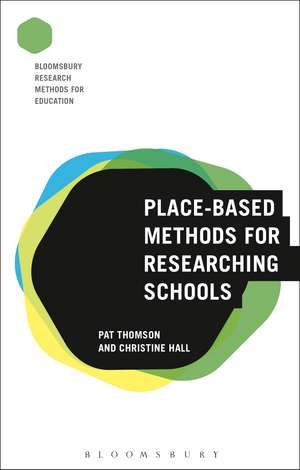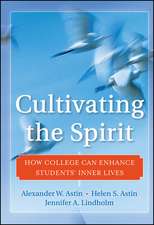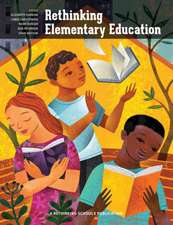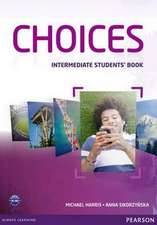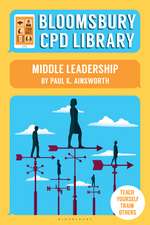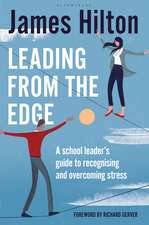Place-Based Methods for Researching Schools: Bloomsbury Research Methods for Education
Autor Professor Pat Thomson, Professor Christine Hallen Limba Engleză Paperback – 14 dec 2016
| Toate formatele și edițiile | Preț | Express |
|---|---|---|
| Paperback (1) | 179.43 lei 22-36 zile | |
| Bloomsbury Publishing – 14 dec 2016 | 179.43 lei 22-36 zile | |
| Hardback (1) | 714.77 lei 22-36 zile | |
| Bloomsbury Publishing – 14 dec 2016 | 714.77 lei 22-36 zile |
Preț: 179.43 lei
Preț vechi: 220.14 lei
-18% Nou
Puncte Express: 269
Preț estimativ în valută:
34.33€ • 35.94$ • 28.41£
34.33€ • 35.94$ • 28.41£
Carte disponibilă
Livrare economică 17-31 martie
Preluare comenzi: 021 569.72.76
Specificații
ISBN-13: 9781474242882
ISBN-10: 147424288X
Pagini: 296
Ilustrații: 25 bw illus
Dimensiuni: 138 x 216 x 18 mm
Greutate: 0.38 kg
Editura: Bloomsbury Publishing
Colecția Bloomsbury Academic
Seria Bloomsbury Research Methods for Education
Locul publicării:London, United Kingdom
ISBN-10: 147424288X
Pagini: 296
Ilustrații: 25 bw illus
Dimensiuni: 138 x 216 x 18 mm
Greutate: 0.38 kg
Editura: Bloomsbury Publishing
Colecția Bloomsbury Academic
Seria Bloomsbury Research Methods for Education
Locul publicării:London, United Kingdom
Caracteristici
Authors understand the school as a place and show how you can bring mutiple mixed research methods together to understand it
Notă biografică
Pat Thomson is Professor of Education in the School of Education at the University of Nottingham, UK. A former headteacher, she works with teachers and artists using action research and ethnographic approaches. Her research focuses on arts, learning and change in educational, gallery, museum and community settings. Christine Hall is Professor of Education in the School of Education at The University of Nottingham, UK. Formerly a secondary school teacher, she has worked in teacher education for the last 20 years supervising numerous students and teachers on school-based research projects. Her research is on literacy and the arts in schools.
Cuprins
List of FiguresList of TablesAcknowledgementsSeries Editor's Preface Glossary of Research Methods and Approaches Introducing the book1. Studying a School 2. Getting Into the School 3. Getting to Know the Neighbourhood 4. Reading the School 5. Living with the School6. Multiple Perspectives on the School7. Analysing Complex Data Sets 8. Writing the SchoolAppendix Bibliography Index
Recenzii
The authors are generous with their suggested further reading and because of the geographical lens offered these are likely to give the reader references that many educational researchers will be unfamiliar with. The quality and depth of the approaches that the authors suggest make me particularly confident in the robustness of these qualitative data generation approaches. However, the authors do not shy away from the quantitative data that can be generated through national databases. A rich picture of one school can be generated if their advice about place-based research is followed. Overall, this book has much to be commended on and I highly recommend it to any researcher involved in school-based research.
Pat Thomson and Chris Hall's imaginative, informed and innovative methodology text book is a must for anyone, from novice to expert, studying any aspect of schools. This is a book to transform both your approach to research and your thinking about schools - and indeed their communities - with new ideas and practical illustrations.
Patricia Thomson and Christine Hall use the literature on space, time and place in combination with that on place-based research projects to provide a map for the field. They write with a deep understanding of a wide range of theory and a commitment to ethical research methods and practices. Their map covers the field of place-based research, offering a clear framework and the necessary know-how. Accessible, interesting and rigorous their work inspires an interest in schools as places, and in place-based methods for researching, understanding and representing them.
This book inspires me to do school research, and to do it well. It takes seriously the many entangled factors - people, places, structures, ideas, experiences, feelings - that make a school, demonstrating the 'specificity, particularity and complexity to the near-universal experience of being in school' and showing us what we might do with this as researchers. The book addresses a sophisticated reader who is able to make her/his own decisions and research plans, but still offers structured insights for thinking practically about how to research schools. It is also a compelling and pleasurable read. After this book, it will be difficult to think of school research that does not engage deeply with the place of a school.
This book is a very useful resource to a beginner school-based researcher. It provides useful advice on various practical aspects of conducting research in schools and outlines some theoretical and methodological foundations and approaches to conducting research with human participants.
This is an excellent student book suitable for both undergraduate and postgraduate students interested in research in schools. Although the focus is on place based methods and there are appropriate and helpful articulations of place and space theory, this book usefully provides a number of practical approaches and a range of references for the reader to follow up. If the mark of a good book is that the reader is left wanting to find out more, this work succeeds (and it is my favourite book of the year!).
Pat Thomson and Chris Hall's imaginative, informed and innovative methodology text book is a must for anyone, from novice to expert, studying any aspect of schools. This is a book to transform both your approach to research and your thinking about schools - and indeed their communities - with new ideas and practical illustrations.
Patricia Thomson and Christine Hall use the literature on space, time and place in combination with that on place-based research projects to provide a map for the field. They write with a deep understanding of a wide range of theory and a commitment to ethical research methods and practices. Their map covers the field of place-based research, offering a clear framework and the necessary know-how. Accessible, interesting and rigorous their work inspires an interest in schools as places, and in place-based methods for researching, understanding and representing them.
This book inspires me to do school research, and to do it well. It takes seriously the many entangled factors - people, places, structures, ideas, experiences, feelings - that make a school, demonstrating the 'specificity, particularity and complexity to the near-universal experience of being in school' and showing us what we might do with this as researchers. The book addresses a sophisticated reader who is able to make her/his own decisions and research plans, but still offers structured insights for thinking practically about how to research schools. It is also a compelling and pleasurable read. After this book, it will be difficult to think of school research that does not engage deeply with the place of a school.
This book is a very useful resource to a beginner school-based researcher. It provides useful advice on various practical aspects of conducting research in schools and outlines some theoretical and methodological foundations and approaches to conducting research with human participants.
This is an excellent student book suitable for both undergraduate and postgraduate students interested in research in schools. Although the focus is on place based methods and there are appropriate and helpful articulations of place and space theory, this book usefully provides a number of practical approaches and a range of references for the reader to follow up. If the mark of a good book is that the reader is left wanting to find out more, this work succeeds (and it is my favourite book of the year!).
